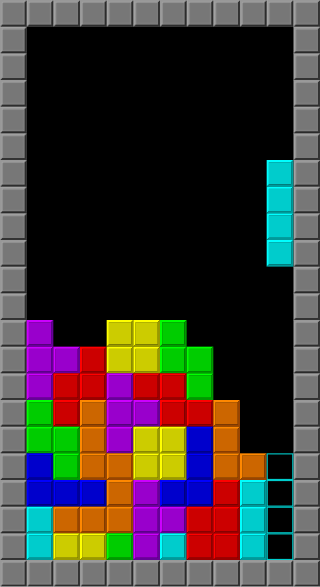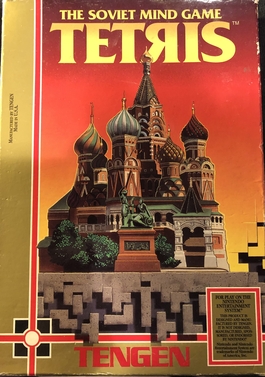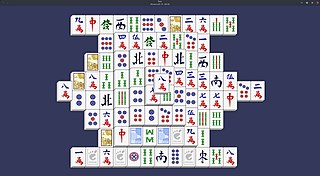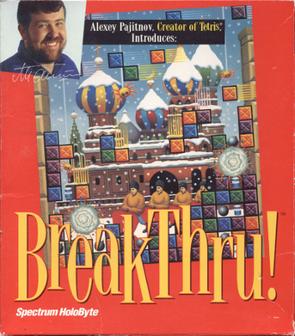
Alexey Leonidovich Pajitnov is a Russian-American computer engineer and video game designer who is best known for creating, designing, and developing Tetris in 1985 while working at the Dorodnitsyn Computing Centre under the Academy of Sciences of the Soviet Union.

Tetris is a puzzle video game created in 1985 by Alexey Pajitnov, a Soviet software engineer. It has been published by several companies for multiple platforms, most prominently during a dispute over the appropriation of the rights in the late 1980s. After a significant period of publication by Nintendo, in 1996 the rights reverted to Pajitnov, who co-founded the Tetris Company with Henk Rogers to manage licensing.

Bejeweled is a tile-matching puzzle video game by PopCap Games, developed initially for browsers in 2001. The first game developed by PopCap under their current name, Bejeweled involves lining up three or more multi-colored gems to clear them from the game board, with chain reactions potentially following.

Klax is a puzzle video game released in arcades in 1990 by Atari Games while Namco distributed the game in Japanese markets. It was designed and animated by Mark Stephen Pierce with the software engineering done by Dave Akers. The object is to catch colored blocks tumbling down a machine and arrange them in colored rows and patterns to make them disappear. Klax was originally published as a coin-op follow-up to Tetris, about which Atari Games was in a legal dispute at the time.

PopCap Games, Inc. is an American video game developer based in Seattle, and a subsidiary of Electronic Arts. The company was founded in 2000 by John Vechey, Brian Fiete and Jason Kapalka.

Tetris is a puzzle game developed by Atari Games and originally released for arcades in 1988. Based on Alexey Pajitnov's Tetris, Atari Games' version features the same gameplay as the computer editions of the game, as players must stack differently shaped falling blocks to form and eliminate horizontal lines from the playing field. The game features several difficulty levels and two-player simultaneous play.

ClockWerx is a puzzle video game created by Callisto Corporation that was released in 1995. The game was originally released by Callisto under the name Spin Doctor. Later, with some gameplay enhancements, it was published by Spectrum HoloByte as Clockwerx, which was endorsed by Alexey Pajitnov according to the manual. A 3DO Interactive Multiplayer version was planned but never released.
A casual game is a video game targeted at a mass market audience, as opposed to a hardcore game, which is targeted at hobbyist gamers. Casual games may exhibit any type of gameplay and genre. They generally involve simpler rules, shorter sessions, and require less learned skill. They do not expect familiarity with a standard set of mechanics, controls, and tropes.

Tetris is a puzzle video game developed and published by Nintendo for the Game Boy in 1989. It is a portable version of Alexey Pajitnov's original Tetris and it was bundled with the North American and European releases of the Game Boy itself. It is the first game to have been compatible with the Game Link Cable, a pack-in accessory that allows two Game Boy consoles to link for multiplayer purposes. A remaster, Tetris DX, was released on the Game Boy Color in 1998. A Nintendo 3DS Virtual Console version of Tetris was released in December 2011, lacking multiplayer functionality. The game was released on the Nintendo Switch Online service in February 2023.

Microsoft Mahjong is a computer game version of mahjong solitaire published by Microsoft. The version titled Mahjong Titans was developed by Oberon Games and included in Windows Vista and Windows 7. It takes advantage of the new graphical user interface (GUI) of Windows Vista, and includes features such as tile set and background choices. The game did not make it to Windows 8; however, a standalone version, developed by Arkadium and published by Microsoft Studios, can be downloaded from the Windows Store free of charge and played without download on the web.

Pandora's Box is a 1999 video game created by Alexey Pajitnov for Microsoft.

Mahjong solitaire is a single-player matching game that uses a set of mahjong tiles rather than cards. It is more commonly played on a computer than as a physical tabletop game.

Bejeweled 3 is a tile-matching puzzle video game developed and published by PopCap Games. It is the fifth game in the Bejeweled series following Bejeweled Blitz and succeeds Bejeweled 2 as the latest mainline title in the Bejeweled series. It was released for PC and Mac on December 7, 2010, as part of the 10 Years of Bejeweled celebration, which celebrated the 10th anniversary of Bejeweled, and has been ported to several other consoles afterward.
Bejeweled is a series of tile-matching puzzle video games created by PopCap Games. Bejeweled was released initially for browsers in 2001, followed by seven sequels: Bejeweled 2 (2004), Bejeweled Twist (2008), Bejeweled Blitz (2009), Bejeweled 3 (2010), Bejeweled LegendBejeweled Stars (2016), and Bejeweled Champions (2020) all by PopCap Games and its parent, Electronic Arts. More than 10 million copies of Bejeweled have been sold, and the game has been downloaded more than 350 million times. By February 2010, Bejeweled sales hit 50 million. The figure includes the original game, plus the Blitz and Twist versions. An arcade version was released in Q3 2013.

A tile-matching video game is a type of puzzle video game where the player manipulates tiles in order to make them disappear according to a matching criterion. In many tile-matching games, that criterion is to place a given number of tiles of the same type so that they adjoin each other. That number is often three, and these games are called match-three games.

BreakThru! is a tile-matching puzzle video game released for the Windows and MS-DOS in 1994. It was created by Steve Fry for the Japanese company ZOO Corporation and published by Spectrum HoloByte, for the North American market.

Puzzlejuice is a 2012 indie puzzle video game for iOS produced and developed by video game company Sirvo. The game is a combination of Tetris, tile-matching, and Boggle: players rearrange falling tetromino blocks into rows of similar colors, which turn into letters that are cleared from the board by forming words. The fast-paced game also includes challenges and power-ups. The development team consisted of three people; programmer Asher Vollmer initially developed the game alone, before reaching out to artist Greg Wohlwend for advice on the aesthetics. Composer Jimmy Hinson produced the game's music.
Tetris is a tile-matching puzzle video game released in 1985.
















